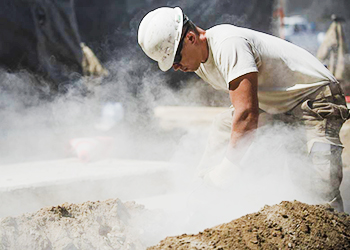Casella UK
Wolseley Rd, Kempston,Bedford MK42 7JY
+44(0)1234844100
info@casellasolutions.com

Approximately 14.8 million adults in the United States have been diagnosed with chronic obstructive pulmonary disease (COPD) with an estimated 12 million people likely to have the condition, but not yet be diagnosed.[1] Many of these cases could be linked to occupational exposure from dangerous airborne dusts, fumes and other substances.
Implementing workplace monitoring solutions could be the key to reducing these statistics. The process provides real-time data about dust levels, enabling employers to identify general areas and specific activities that increase exposure, implementing processes to mitigate risks.
Why Monitor?
OSHA recognizes the importance for employers to protect workers from hazardous substances and to keep them to a reasonable level within Permissible Exposure Limits (PELs). This applies to substances such as metal, coal, silica dust and toxic fumes with different maximum exposure limits, indicating when exposure becomes potentially hazardous to health and employers must react.[2]
Highlighting the importance of maintaining healthy PELs, OSHA enforced a new regulation on the 23rd September 2017, to reduce workers exposure to crystalline silica. The regulation stipulates that personal exposure should be limited to 50 micrograms of respirable crystalline silica per cubic metre of air (μg/m3), over an eight-hour period.
This places more stringent requirements on employers to implement better methods to reduce exposure. These include monitoring programmes and maintaining records of exposure, offering medical examinations and training to individuals about silica related hazards and how to limit exposure. OSHA estimates this new rule could save up to 700 lives per year.
To comply with the standard, the following schedule must be adhered to:
- If initial results indicate exposures are below the action level (25 μg/m3), no additional monitoring is necessary
- If the monitoring results indicate exposures are above the action level, but below the PEL, additional monitoring would be required within 6 months
- If the exposure monitoring indicates exposures above the PEL, additional monitoring must be repeated within 3 months
- If subsequent monitoring (not the initial monitoring) indicates exposures are below the action level, the employer must repeat the monitoring until two consecutive measurements (taken 7 or more days apart) are below the action level. At that point, the employer can discontinue monitoring
Monitoring solutions are effective in measuring exposure limits, ensuring appropriate action is taken if levels are exceeded.
Dust monitoring
Before implementing any monitoring solution, the first action needed is a proper risk assessment which will answer some key questions:
- Who is exposed and to what?
- How long are they exposed for?
- How much are they exposed to?
Monitoring must be done in a way that it does not impact the comfort or productivity of a worker. Real -time dust monitoring solutions generally can be used for general spot checks, walk-through surveys and individual monitoring, detecting the total level of dust in the air. These instruments highlight exactly when and where excessive dust levels are occurring to support real-time rapid decision-making. Monitoring is a procedure that instantly yields results, equipping employers and employees alike with greater knowledge, leading to positive workplace health programs. For crystalline silica, personal monitoring is essential, and employers must look for personal dust sampling pumps.
Integrating monitoring pumps should become an established part of the health and safety process for companies, saving valuable time, protecting employees that could enhance business efficiency.
Forward focus
The number of American’s suffering from respiratory conditions as the result of workplace exposure is a serious issue and to ensure such cases are reduced, monitoring is critical.
Tim Turney, Technical Product Manager Casella
Discover our range of dust monitoring solutions
This article was first published in December 2017 edition of Powder and Bulk Solids
[1] https://www.healthypeople.gov/2020/topics-objectives/topic/respiratory-diseases
[2] https://www.osha.gov/dsg/annotated-pels/tablez-2.html